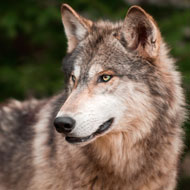
Study shows how zone might have a vital role to play in conservation
Young wolves living inside the Chernobyl Exclusion Zone (CEZ) are moving beyond it and could be interacting with other wolf populations, according to new research.
The study, led by the University of Missouri, tracked 13 adult wolves and one juvenile by fitting them with GPS collars. While the adults stayed within the CEZ, the juvenile roamed far beyond the boundaries.
Lead author of the study Michael Byrne said: “When wolf populations get as dense as they are in the zone, the young must spread out to find their own space and resources. This young wolf was doing just that, and it shows us for the first time that Chernobyl wolves are dispersing into other areas.”
Researchers observed the young wolf move away from its home range within three months of beginning the study. Over the course of 21 days, it travelled more than 229 miles, ending up around 180 miles outside of the zone.
Due to a problem with the GPS collar, the team were unable to see if the wolf returned to the CEZ or remained permanently outside. Nevertheless, the study is the first of its kind to show a wolf going being the CEZ and possibly interacting with wolf populations outside of the zone.
Researchers say the zone has the potential to help ensure the connectivity of wildlife populations across the larger landscape, making grey wolves in the region more resilient as a species. However, the study does also raise the possibility that wildlife leaving the CEZ could spread mutations to other populations.
The study, “Evidence of long-distance dispersal of a grey wolf from the Chernobyl Exclusion Zone,” was published in the European Journal of Wildlife Research.



 The veterinary mental health charity Vetlife is inviting the veterinary community to join it for a sponsored cold-water dip.
The veterinary mental health charity Vetlife is inviting the veterinary community to join it for a sponsored cold-water dip.